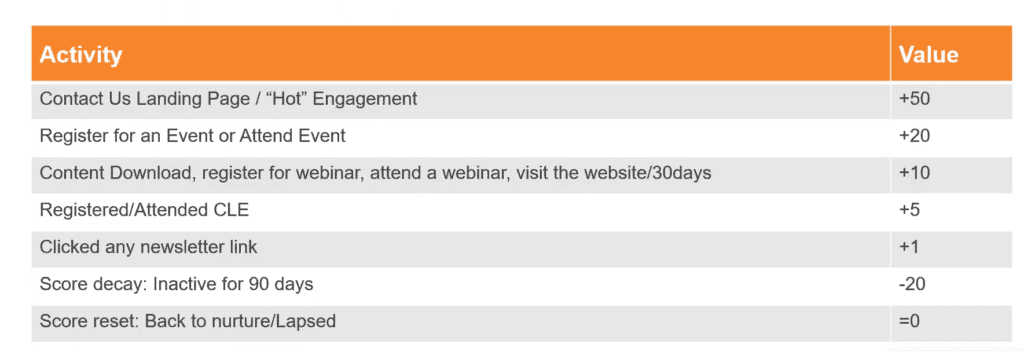Member Engagement Scoring
How Associations Can Measure Digital Engagement Levels

In a perfect world, all your association’s members would attend your conference, read every piece of content that you offered them, and be ready to volunteer or mentor at any time to further the profession, the industry, or your organization’s initiatives.
But that’s not exactly the reality. Different members might engage with your association a different times during their fiscal year and throughout their career – and that’s okay! You don’t need 100% of members engaged 100% of the time. However, you DO want to keep an eye on engagement so you can:
- Identify members who might be too disengaged to be getting value (they may be at risk of lapsing!)
- Identify members who are deeply engaged and lean on them to share their expertise and enthusiasm to benefit the industry and organization.
How Do You Know What Members are Engaged and Disengaged?
Many organizations take the classic approach to member engagement: When a member joins, the association welcomes them to the organization. Yearly, they might spend time with them at the annual conference. Monthly, weekly, or daily, they might send out a newsletter. And (usually annually), when the time is right, they’ll remind them it’s time to renew. And this cycle repeats every year.
While this can work for some members, it’s not the best member engagement strategy. It also leaves you and your organization in the dark about each member’s engagement levels.
Other associations might rank members based on tenure. And while renewing over and over again is one good indicator of loyalty and involvement, it’s not really a real-time measurement of whether a member is engaged. There are plenty of other indicators you might be missing, like attending an event, reading resources on your website, or contributing in your online member community.
A more strategic way to keep track of your member engagement is through something called engagement scoring.
What is Engagement Scoring for Associations?
You may be familiar with the term “lead scoring,” which is a foundational concept for email marketing and sales.
Lead scoring is a way for marketing and sales teams to automatically rank prospective customers based on their level of interest. The rankings are usually based a point system that assigns a certain amount of points for different actions someone takes; fewer points are assigned to low-value interactions, like opening an email, and more points are assigned to higher-value interactions, like attending a webinar. In a way, lead scoring is equal parts art and science, in that you can choose what numbers to assign to your list.
The goal of lead scoring is to build a systematic process for figuring out when someone is primed to receive outreach from your organization. By determining sales readiness, lead scores help companies ensure their outreach to prospects remains respectful and helpful.
Similarly, for associations, engagement scoring can help you group members based on their actions and/or decide when your members are ready for certain types of outreach. And because you decide what you want to track, and which actions you want to assign points for, it’s a really flexible methodology that can be used in a lot of different ways!
- You might use engagement scoring for member sales, assigning point values to prospective members who visit your membership webpage or open membership promotional emails.
- You might use engagement scoring to help identify people who are ready to sit for a certification exam or seem to be displaying interest in a professional development opportunity you offer.
- You can use also engagement scoring to group people by tenure, participation in events, contributions to discussions, and what they seem to be most interested in.
- Most frequently, we see engagement scoring used (as the name suggests) to gauge engagement levels for existing members.
- Or all of the above! The beauty of engagement scoring is, you can decide on multiple scoring rubrics for multiple scoring initiatives.
Like lead scoring, the most common way to build these engagement scores is through a point system. You decide what actions you think indicate interest or engagement, then assign points based on different actions someone might take that indicate their LEVEL of interest or involvement.
For example, if you were planning engagement scoring to gauge engagement levels or existing members, you might decide say: opening the newsletter counts for 5 points; clicking on a link from the newsletter counts for 10 points; registering for a member webinar counts for 25 points; completing a certification counts for 40 points, and so on. You can add points based on any number of variables, such as tenure, organizational involvement, and email clicks and responses.
This exact science of your point system depends on the unique dynamics of your organization. It’s up to your team to determine what’s considered “highly engaged, moderately engaged, minimally engaged, or disengaged.”
How to Get Started with Engagement Scoring
Having a way to measure and score members based on their activity with engagement scoring is hugely helpful. But you might be asking yourself: who has the time to manually track down every member’s activity? No one does. That’s why we recommend using marketing automation software to help.
Higher Logic Thrive Marketing, for example, comes with built-in engagement scoring tools so you can develop these benchmarks and assign scores to individual members based on their real-time activity. For associations who want to engage members more strategically and communicate in a personal way, having that engagement scoring technology and being able to automate communication based on scores is a game-changer.
3 Levels of Engagement Scoring
Let’s walk through three levels of engagement scoring – starting with the basic level. If you’ve never used lead or engagement scoring in an email campaign tool before, this is where to start.
Level 1: Start Gathering Base Levels of Engagement Data
Ready to identify who is engaged or not engaged?
- Decide what actions you feel indicate engagement and how much you feel they’re worth in comparison to each other. These can include any actions you can track, for example:
- Web, email, or online community interactions.
- Renewals, volunteering, mentoring, contributions to your online community.
- Decide what actions you feel are worth subtracting points for, for example:
- Unsubscribes – they’re indicating they don’t want to receive email or digital content from you.
- Subtracting points can also be a way to account for inactivity or when your member has taken an action that means they don’t want to receive more content from your organization.
Tip: Engagement scoring doesn’t only have to be based on engagement actions. For example, you might have information in your database you can use to reward them with points (like awards or committee participation) that you might want to count so people get ranked or enrolled in a specific workflow.
Level 2: Add Complexity to Your Engagement Scoring
- Score on repeated activity or frequency. For example, add points after they’ve clicked through 10 emails, or maybe they’ve posted in your online community 3x in one month.
- Add varying levels of scores for more valued activity. For example, maybe a website visit or a webinar attendance is worth more to you than an email open, so give that more points.
- Start thinking about adding recency to the frequency. Did they participate in the last month vs. the last year?
- Alter your positive and negative points as you learn to create better benchmarks.
Level 3: Start Thinking About Different Types of Scoring Categories
Once you feel comfortable tracking simple “engagement vs. disengagement,” think about other specific categories of engagement or behavior you might want to track. Remember, engagement scoring, at it’s simplest, is a way to group people based on what they’re doing. So if you want to be able to reach out to a group of members who’ve all done actions you think indicate their interest in a certification, or a particular topic area you cover, that could present an opportunity for scoring. Some options include:
- Break out categories and topic, like advocacy or education. By doing this you can start who’s interested in what because you can see what categories people have the most points, indicating where they’re the most engaged.
- Use the Level 1 approach for each topic area to assign points.
- Use the Level 2 approach to observe level of interest.
- Add more categories as needed.
- Alter your categories and topics as they evolve.
If you’re interested in setting up engagement scoring but you’re not sure where to get started, we can help! Higher Logic has expert advisors who are available to help you on a project-focused or ongoing basis, through our Services offerings.
Here’s an Example of Engagement Scoring
Here’s what a possible member engagement score might look like when you’ve gone through Levels 1-3.

In Higher Logic Thrive Marketing you can set up lead/engagement scoring and have it run automatically. Then, when you’re ready, you can use the data to find members who can:
- Present at an event or a webinar
- Volunteer or mentor
- Engage in the online community
- Contribute to advocacy efforts
- Respond to surveys
There are a lot of different ways you can benefit from using engagement scoring. Our customers have used engagement scoring to:
- Create benchmarks. With engagement scoring, understand how many members are engaged by month, quarter, and year. Then you can see increases or decreases based on those numbers.
- Find content gaps or successes. When you can track member engagement, you can also track whether your content is working to engage members or not and where you need to improve. If you need more data on why content is or isn’t working, a good first step is to conduct interviews with your association members. What information do they want? What are some of their challenges? Then look to other sources of data – what are the top discussion posts in your online community? What are the top community searches?
- Personalize your engagement strategies and build affinity. Your members will benefit because you can target email messages based on their interests and based on what you know they want and need. With more personalized communications they have less noise and distraction – and the messages they receive from you are relevant, leading to increased engagement.
- Identify the right time to engage with members or prospective members. When is it the right time to invite nonmembers to join your association? When is it the right time to ask them to get involved? Now you’ll know.
The best part of your engagement scoring system is the built-in feedback loop. When you consistently match members with valuable content, they will discover more value. The more engaged they are, the more your association will thrive. And a thriving association, as we all know, leads to member retention.
For this reason, creating an engagement scoring structure in your marketing automation platform has the potential to become one of the most valuable investments and positivity-drivers in your organization.
This post was originally published April 13,2021. It has since been updated.
Ready to level-up with marketing automation?
Higher Logic Thrive Marketing is a completely scalable marketing solution. Confidently send the right message to the right members at the right time!






